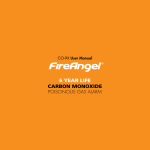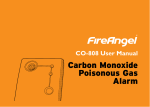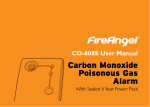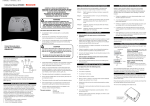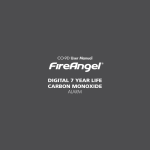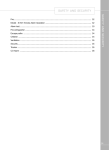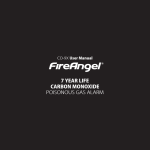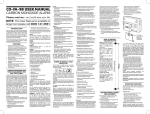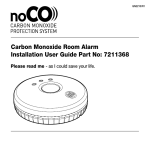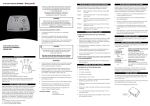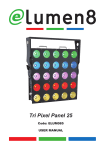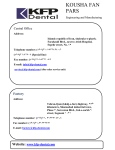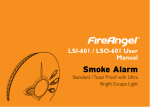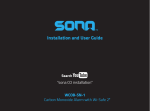Download Digital Carbon Monoxide Poisonous Gas Alarm
Transcript
CO-828 User Manual Digital Carbon Monoxide Poisonous Gas Alarm Contents Page Introducing your Carbon Monoxide Detector 1 Carbon Monoxide and how it can affect you and your family 3 Where to install your detector 7 How to install your detector 10 Battery installation/replacement 11 Operating features 13 Unit malfunction “Err” 21 Maintaining/testing your detector 22 What to do in the event of an alarm 23 Technical Information 24 Warranty information 26 Disposal 27 Returns 28 Introducing Your FireAngel Carbon Monoxide Detector Congratulations! You've made a wise investment in an innovative product and your personal safety.The FireAngel is one of a new generation of domestic life safety products from FireAngel Limited, which combines the latest technology and innovative design to provide an aesthetically pleasing and effective contribution to your fire safety. The FireAngel range of products is constantly being improved and expanded. Please visit www.FireAngel.co.uk to find out about the latest additions to our product range. FireAngel manufactures one of the most technologically advanced carbon monoxide detectors in the world. 1 Features • an advanced electrochemical sensor designed to accurately measure low levels of carbon monoxide (CO) providing an early warning of toxic CO levels in your home • detects carbon monoxide continuously • resistant to false alarms caused by normal household contaminants • sounds a loud 85dB alarm to alert you in case of an emergency • digital readout of CO level in parts per million (ppm) • remembers peak CO level occurring over a four week period • test/reset button • icons to identify various status conditions • simple to mount, portable, ideal for travelling • certified to the British Standards Institute (BSI) Carbon Monoxide Standard BS EN 50291: 2001 • 5 year warranty (batteries excluded) 2 Carbon Monoxide and How It Can Affect You and Your Family Carbon monoxide is a dangerous, poisonous gas that kills hundreds of people each year and injures many more. It is often referred to as the silent killer because it has no odour or taste and cannot be seen. Like oxygen, CO enters the body through the lungs during the normal breathing process. It competes with oxygen by replacing it in the red blood cells, thereby reducing the flow of oxygen to the heart, brain and other vital organs. In high concentrations, CO can kill in minutes. Many cases of reported CARBON MONOXIDE POISONING indicate that while victims are aware they are not feeling well, they become disorientated and unable to save themselves by either exiting the building or calling for assistance. Exposure during sleep is particularly dangerous because the victim usually does not wake up. Symptoms of CO poisoning The following symptoms may be related to CO poisoning and should be discussed with all members of the household: • Mild Exposure: Slight headache, nausea, vomiting, fatigue (often described as ‘flu-like’ symptoms). • Medium Exposure: Severe throbbing headache, drowsiness, confusion, fast heart rate. • Extreme Exposure: Unconsciousness, convulsions, cardiorespiratory failure, death. 3 35ppm - The maximum allowable concentration for continuous exposure for healthy adults in any 8 hour period, as recommended by the Occupational Safety and Health Administration (OSHA). 200ppm - Slight headache, fatigue, dizziness, nausea after 2-3 hours. 400ppm - Frontal headaches within 1-2 hours, life threatening after 3 hours. 800ppm - Dizziness, nausea and convulsions within 45 minutes. Unconsciousness within 2 hours. Death within 2-3 hours. Should you suspect CO may be affecting you or your family, open the doors and windows of your residence to ventilate, turn off your appliances and evacuate the premises. At this time the authorities should be contacted to locate the source of the carbon monoxide before re-entering the building. Medical attention should be sought for anyone suffering the effects of CO poisoning (headache, nausea, see page 3). Common Sources of CO • • • • • Oil and gas furnaces Barbecues Gas appliances Gas or kerosene heaters Cigarette smoke • • • • • 4 Wood stoves Wood or gas fireplaces Portable generators Clogged chimneys Any fossil fuel burning appliance WARNING: This FireAngel carbon monoxide detector is not a combustible gas detector, nor a smoke detector. Please install the proper detectors to detect combustible gases, or smoke.This CO detector should not be seen as a substitute for the proper servicing of fuel-burning appliances, nor the sweeping of chimneys. WARNING: Do not use this carbon monoxide detector on an intermittent basis, or as a portable detector for trying to trace one source of the spillage of combustion products from fuel-burning appliances or from chimneys. DO NOT: • • • • • • • • IGNORE ANY WARNING FROM YOUR CO DETECTOR! burn charcoal inside your home, caravan, tent or cabin. install, convert or service fuel-burning appliances without proper knowledge, skill and expertise. use a gas range, oven or clothes dryer for heating. operate unvented gas burning appliances using kerosene or natural gas in closed rooms. operate gasoline-powered engines indoors or in confined areas. ignore a safety device when it shuts an appliance off. use as a portable detector for the spillage of CO from fuel-burning appliances or chimneys. 5 EDUCATE YOURSELF AND YOUR FAMILY ON THE SOURCES AND SYMPTOMS OF CO POISONING AND HOW TO USE YOUR CARBON MONOXIDE DETECTOR: • buy appliances accepted by a recognised testing laboratory • install appliances according to the manufacturer’s instructions • have appliance installations done by professionals (CORGI registered for gas appliances) • have your appliances checked regularly by a qualified serviceman • clean chimneys and flues yearly • make regular visual inspections of all fuel-burning appliances • do not barbecue indoors, or in an attached garage • open windows when a fireplace or wood burning stove is in use • install only CO detectors that meet the requirements of BS EN 50291:2001 in your home • be aware of CO poisoning symptoms 6 Where To Install Your Detector WARNING: This detector will only indicate the presence of carbon monoxide gas at the sensor. Carbon monoxide gas may be present in other areas. In which room should the detector be installed? Ideally, an apparatus should be installed in every room containing a fuel burning appliance. Additional apparatus may be installed to ensure that adequate warning is given for occupants in other rooms, by locating apparatus in: • remote rooms in which the occupant(s) spend considerable time whilst awake and from which they may not be able hear an alarm from apparatus in another part of the premises, and • every sleeping room. However, if there is a fuel burning appliance in more than one room and the number of apparatus is limited, the following points should be considered when deciding where best to put the apparatus: • locate the apparatus in a room containing a flueless or open-flued appliance, and • locate apparatus in a room where the occupant(s) spend most time. • If the domestic premises is a bedsit (a single room serving as both sitting and bedroom) then the apparatus should be put as far from the cooking appliances as possible but near to where the person sleeps. • If the appliance is in a room not normally used (for example a boiler room), the apparatus should be put just outside the room so that the alarm may be heard more easily. Alternatively, a remote alarm siren may be connected to a type A apparatus located in a room(s) containing a fuel-burning appliance. 7 Where in the room should I place the detector? Apparatus located in the same room as a fuel burning appliance If the apparatus is located on a wall: a) it should be located close to the ceiling; b) it should be located at a height greater than the height of any door or window. And it should be at least 150mm from the ceiling. The apparatus should be at a horizontal distance of between 1m and 3m from the potential source. If there is a partition in a room, the apparatus should be located on the same side of the partition as the potential source. Carbon Monoxide alarms in rooms with sloped ceilings should be located at the high side of the room. Apparatus located in sleeping rooms and in rooms remote from a fuel burning appliance Apparatus located in sleeping rooms and in rooms remote from the fuel-burning appliance should be located relatively close to the breathing zone of the occupants. 8 Do not put the detector The apparatus should not be installed: In an enclosed space (for example in a cupboard or behind a curtain). Where it can be obstructed (for example by furniture). • • • • • • • • directly above a sink next to a door or window next to an extractor fan next to an air vent or other similar ventilation openings in an area where the temperature may drop below -10°C or exceed 40°C where dirt and dust may block the sensor in a damp or humid location in the immediate vicinity of the cooking appliance 9 How To Install Your Detector Note: This carbon monoxide alarm must be installed by a competant person To install your unit, follow the illustration below. Your detector should be installed on the wall. To Mount on the Wall: Hold the mounting bracket against the wall and mark the inside location of each keyhole. Drill a 5mm (3/16”) hole into the wall. Insert the plastic screw anchors into the mounting holes. Screw the mounting bracket to the wall. Now install the approved 9 volt alkaline battery required, as provided with your detector. 10 Battery Installation/Replacement See diagrams on page 11 a. If the detector is wall mounted, flip the detector casing down so that the battery compartment is exposed. b. Remove the battery cover. c. Replace the battery with an approved 9 volt alkaline battery (see page 24 for a list of approved batteries), making sure the battery terminals align properly with the terminals on the battery clip and push the battery into place. Replace the battery cover and return the detector to the original position. d. When the battery is connected, your detector will first display all the icons.The digital readout will then display a ‘0’, the PPM readout will flash, the LED will flash yellow and the detector will beep to indicate that the battery is properly connected. e. Your advanced FireAngel detector requires a short ‘warm-up’ period before it is fully operational. If you have followed all of the above steps correctly, your unit will begin monitoring for CO in around 3 minutes.The flashing PPM symbol is your assurance that the unit is receiving power. When the 3 minute warm-up period is complete, the LED will flash green once per minute as an additional indication that the alarm is receiving power from the battery and is fully operational. If there are problems with your unit the LED will flash yellow instead of green, a single chirp once per minute will be emitted and the digital display will flash ‘Err’ to indicate that the alarm has malfunctioned (see page 21). f. Test the the horn and battery by pressing the Test/Reset button briefly to confirm that the detector is operating properly.The detector should sound as soon as the button is pressed, indicating that the horn is working and the battery is providing power to the unit. Release the Test/Reset button to silence the horn. The horn and battery should be tested on a weekly basis. Warning: Prolonged exposure to the horn in close proximity will damage your hearing. 11 a. b. d. c. e. Under normal operating conditions, the battery should last for 1 year. When the unit is in full alarm the battery life is 7 days (from full capacity).The detector will not protect against the risk of CO poisoning when the battery has drained. Warning: Constant exposure to extreme high or low temperatures may reduce battery life. 12 f. Operating Features Your FireAngel detector offers many features which set it apart from other CO detectors on the market today. Test/Reset Button Feature This button will: • reset the peak level memory of your alarm (see page 16) • test your sensor, horn and battery • silence the loud 85dB horn during an alarm (only for an alarm due to levels below 50ppm) • when held down, the readout will display the peak level of CO recorded over the last 4 weeks • resets the peak level memory and alarm icons displayed following an alarm • allows you to test the sensor by introducing a source of CO into the detector 13 Digital Display and Action Prompt Digital Display FireAngel’s unique digital readout displays the amount of CO in the area of the sensor, expressed in parts per million (ppm).Your detector is designed to display levels from 10ppm to 999ppm. Note: Ambient background levels between 0ppm and 10ppm will register as 0ppm on the display. 14 Testing the Horn and Battery Test the unit by pressing the Test/Reset button briefly to confirm that the detector is operating properly. The detector should sound as soon as the button is pressed, indicating that the horn is working and the battery is providing power to the unit. Release the test/reset button to silence the horn.The horn and battery should be tested on a weekly basis. 15 Peak Level Reading Feature The peak level reading is the highest level of CO recorded by the unit over the last four weeks. To display the peak level reading firstly place your left thumb or finger over the sounder vent (see diagram), then press and hold the Test/Reset button down with your right thumb or finger.The horn will sound and the detector will display the peak level reading stored in the memory until you release the button or for a maximum of 4 seconds. This feature is helpful to a technician servicing your home or possibly to yourself when returning home after a period of time and discovering the high or low level icon displayed on the digital display indicating that the alarm has sounded in your absence. Holding the Test/Reset button down for 5 seconds will reset the peak level reading to ‘0’. Replacing the battery will also cause the peak level reading to reset to ‘0’. 16 Testing The Sensor If testing the sensor for the first time after installation, or replacing a battery, make sure that the alarm has completed the 3 minute warm up period and the LED is flashing green once every minute, as carrying out a sensor test before this could give false readings. CAUTION: All sensor testing should only be performed by a responsible adult. This test should only be performed once a month. Excessive testing will cause the battery life to be shortened. NOTE: CO test kits may be used in order to avoid having to burn cigarettes, incense sticks etc. We suggest the use of an incense stick or cigarette as the inefficient way in which they burn gives off a readable localized amount of CO. A readable level of carbon monoxide will not be given off by other sources of smoke, for example an extinguished candle or match. Step 1: If the alarm is wall mounted unhook it from the fixing screws. Step 2: Cover sounder vent with left thumb/finger (see previous diagram on opposite page). Hold the Test/Reset button down for around six seconds until the Spray Can Icon is visible.This indicates that the detector is now monitoring continuously for CO and may be tested using a known source of CO. Step 3: Light a cigarette or an incense stick using a match or lighter. Extinguish the lighter, or put out the match and place it into a dish of water. 17 Step 4: Turn the alarm on its side so that the vents nearest the Test/Reset button on the side of the alarm are pointing downwards (see diagram opposite). Hold the burning cigarette or incense stick 15-20cm (6-8 inches) below the detector, so that the smoke moves towards the holes in the sides of the detector.The display will indicate the amount of CO in the smoke (it may take up to 2 minutes for a reading to be shown). An increase in the reading on the digital display will indicate that the sensor and electronics are working properly. Note: The alarm will only sound if excessive amounts of CO are detected during this short test. Step 5: Put out the cigarette or incense stick by placing it into a dish of water. Ensure that all flames have been extinguished. Step 6: The spray can icon will disappear after four minutes, and the detector will return to normal monitoring mode. Note: If the spray can icon flashes press the Test/Reset button once to return to ‘sensor testing’ mode. 18 15 - 20cm (6 - 8”) High Level Icon The time it takes for your FireAngel CO detector to alarm is directly related to the concentration of CO that it detects.Your FireAngel CO alarm will respond more quickly the higher the concentration of CO. If a high level of CO (above 50ppm) has been detected for a specified period of time, the LED will flash red once every 2 seconds, the high level alarm icon will appear, and a loud (min 85dB at 1 metre) alarm will sound.The unit will remain in alarm until the level of CO detected falls below 50ppm. It is not possible to reset the alarm if the sensor is reading more than 50ppm or more. If the high level icon is visible but the horn is not sounding, the detector has sensed a high level of CO in your absence. Immediately vacate the premises and seek medical attention.Treat this as a serious warning. Call a qualified technician and have the problem investigated and rectified immediately. Low Level Icon If the sensor detects a level between 30ppm and 50ppm for more than 2 hours then a loud (min 85dB at 1 metre) alarm will sound, the LED will flash red once every 2 seconds and the low level alarm icon will be displayed. 19 When the level of CO that has been detected is less than 50ppm it is possible to silence the alarm by pressing the Test/Reset button on the front of the detector. (If the detector has gone into alarm due to levels higher than 50ppm you will not be able to silence the alarm. In this case the alarm will silence automatically when the level of CO detected falls below 50ppm.) If the low level icon is visible but the horn is not sounding, the detector has entered a low level alarm condition in your absence.The CO levels have since returned to levels low enough, or to zero, so that the alarm no longer sounds.The icon remains on to alert you that the CO detector has sounded.This icon can be removed by pressing and holding the Test/Reset button. Continued low level alarms are an indication that the potential of a high level alarm exists.You should treat this alarm very seriously. Prolonged low levels of CO are believed to cause brain damage and heart disease, particularly in children and pregnant women. Call a qualified technician and have the problem investigated and rectified immediately. Low Battery Icon When your battery needs replacing, the low battery icon will appear, the LED will continue to flash green and the unit will emit a single chirp once every minute for a minimum of 7 days. Replace the battery immediately! 20 “Err” – Unit Malfunction The unit continuously checks the settings of its sensor and circuitry. If any of these settings are found to be incorrect, the display will read “Err” for error, the alarm will emit a single chirp once per minute, and the LED will start to flash yellow instead of green. If the detector has a fresh battery and the PPM symbol is not flashing, or the LED does not flash green once per minute (after the 3 minute warm up period is complete), the detector has malfunctioned. Note: This does NOT mean that the alarm has detected Carbon Monoxide. In the event of a malfunction contact the FireAngel Technical Support Team between 9:00am - 5:00pm, Monday - Friday Telephone: 024 7623 6663 (1-800 523171 in Eire) or via e-mail: [email protected] 21 Maintaining/Testing your Detector Maintenance Your detector will alert you to potentially hazardous CO concentrations in your home when maintained properly.To maintain your FireAngel detector in proper working order, and to ensure that your sensor will maintain its 6 year life, it is recommended that you: • Test the horn and battery of your detector at least once per week by pressing the Test/Reset button briefly (see page 15). • Perform the Sensor Test once every month (see page 17). • Keep the detector free of dust by gently vacuuming the case with a soft brush attachment once per month. To prevent the possibility of contaminating the sensor in your alarm and thus affecting its reliability:• Never use cleaning solutions on your detector. Simply wipe with a slightly damp cloth. • Do not paint the detector. • Do not spray aerosols on or near the detector. • Do not use any solvent based products near the detector. • Move the detector to a safe location and store in a plastic bag before painting, wall papering, using or performing any other activities that use materials that emit strong fumes. Remember to remove it from the bag and replace the detector when these activities are finished. 22 What To Do In The Event Of An Alarm WARNING: A loud alarm is a warning that high and potentially lethal levels of carbon monoxide are present. Never ignore this alarm, further exposure can be fatal. Immediately check residents for symptoms of carbon monoxide poisoning, and contact the proper authorities to resolve all CO problems. NEVER IGNORE A LOW-LEVEL OR HIGH-LEVEL ALARM. Please carefully review this owner’s manual to ensure that you know what actions to take in the event of both high and low-level alarms. What To Do During A High-Level Alarm • • • • Keep calm and open the doors and windows to ventilate. Turn off the appliance where possible and stop using the appliance. Evacuate the property leaving the doors and windows open. Ring your gas or other fuel supplier on their emergency number; keep the number in a prominent place. Write your fuel supplier’s emergency number here; ____________________________________ • Do not re-enter the property until the alarm has stopped. • Get medical help immediately for anyone suffering the effects of carbon monoxide poisoning. (headache, nausea), and advise that carbon monoxide poisoning is suspected. • Do not use the appliance again until it has been checked by an expert. In the case of gas appliances this must be a CORGI registered installer. 23 What To Do During A Low-Level Warning • Open all doors and windows to ventilate. • Turn off all appliances that are potential sources of CO when possible, and stop using the appliance.These may include gas and wood-burning fireplaces, all gas appliances, and barbecues. • Note the reading on the display. • Silence the alarm and turn off the low-level icon by pressing the Test/Reset button. • Do not use the appliance again until it has been checked by an expert. In the case of gas appliances this must be a CORGI registered installer. • Get medical help immediately for anyone suffering the effects of carbon monoxide poisoning (headache, nausea), and advise that carbon monoxide poisoning is suspected. Technical Information Detector Specifications: Sensor Type: Sensor Life: LCD Readout Range: Readout Accuracy: Alarm Sound Level: Model CO-828 Electrochemical 6 Years 10 – 999ppm +/- 20% at 100ppm 85dB at 1 meter (3 feet) 24 Recommended Batteries: Duracell MN1604, Energizer 522, Gold Peak 1604A Battery Life: Exceeds 1 year, replaceable Temperature Range: -10ºC (14ºF) to 40ºC (104ºF) Operating Humidity Range: 30-90% RH Weight: 228 grams (10 oz), including battery Certified to: BS EN 50291:2001 The FireAngel carbon monoxide detector is designed to monitor for CO and to display levels between 10 and 999ppm where a reading of more than 10ppm is detected at the sensor. If the level of CO detected at the sensor is less than 10ppm, then the display will read 0ppm. The following response times meet the requirements of the British Standard BS EN 50291:2001. The high-level alarm will sound: • Between 60 and 90 minutes when exposed to 50ppm of CO. • Between 10 and 40 minutes when exposed to 100ppm of CO. • Within 3 minutes of exposed to 300ppm of CO. The low level CO warning will activate when concentrations of CO of more than 30ppm but not more than 50ppm have been detected for at least 2 hours. WARNING: APPARATUS CONFORMING TO THIS STANDARD MAY NOT PROTECT PEOPLE WHO ARE AT SPECIAL RISK FROM CARBON MONOXIDE EXPOSURE BY REASON OF AGE, PREGNANCY OR MEDICAL CONDITION. IF IN DOUBT, CONSULT YOUR MEDICAL PRACTITIONER. A CARBON MONOXIDE DETECTOR IS NOT A SUBSTITUTE FOR A SMOKE ALARM OR A COMBUSTIBLE GAS DETECTOR. REPLACE UNIT AFTER 5 YEARS OF OPERATION. 25 5 Year Warranty Information Warranty Coverage: FireAngel Ltd warrants to the original purchaser that its enclosed carbon monoxide alarm be free from defects in materials and workmanship under normal residential use and service for a period of 5 (five) years from the date of purchase. Provided it is returned with postage prepaid and proof of purchase date, FireAngel Ltd hereby warrants that during the 5 (five) year period commencing from the date of purchase FireAngel Ltd, at its discretion, agrees to replace the unit free of charge.The warranty on any replacement FireAngel CO-828 Carbon Monoxide Alarm, will last for the remainder of the period of the original warranty in respect of the alarm originally purchased – that is from the date of original purchase and not from the date of receipt of the replacement product. FireAngel Ltd reserve the right to offer an alternative product similar to that being replaced if the original model is no longer available or in stock. This warranty applies to the original retail purchaser from the date of original retail purchase and is not transferable. Proof of purchase is required. 26 Warranty Disclaimers: This warranty does not cover damage resulting from accident, misuse, disassembly, abuse or lack of reasonable care of the product, or applications not in accordance with the user manual. It does not cover events and conditions outside of FireAngel Ltd’s control, such as Acts of God (fire, severe weather etc). It does not apply to retail stores, service centres or any distributors or agents. FireAngel Ltd will not recognise any changes to this warranty by third parties. FireAngel Ltd. shall not be liable for any incidental or consequential damages caused by the breach of any express or implied warranty. Except to the extent prohibited by applicable law, any implied warranty of merchantability or fitness for a particular purpose is limited in duration for 5 (five) years. This warranty does not affect your statutory rights. Except for death or personal injury, FireAngel shall not be liable for any loss of use, damage, cost or expense relating to this product or for any indirect, or consequential loss, damages or costs incurred by you or any other user of this product. Disposal Waste electrical products should not be disposed of with household waste. Please recycle where facilities exist. Check with your local authority, retailer or manufacturer for recycling/ disposal advice as regional variations apply. The battery should be disconnected before disposal.You can also return your carbon monoxide alarm for disposal. For return address see the section on Returns. Please include a note confirming the product is being returned for disposal. WARNING: DO NOT ATTEMPT TO OPEN - DO NOT BURN 27 Returns: We recommend that you contact the FireAngel Technical Support Line in the first instance on 024 7623 6663 (1-800 523171 in Eire) or via e-mail: [email protected] as we may be able to remedy the problem quickly over the phone (this is to prevent unnecessary returns that take a longer time to process). If there is a fault that we are unable to resolve then our technical support engineer will issue you with a returns authority number so that your product can be returned for testing. To return your FireAngel under warranty, send it suitably packed and disabled (this will be explained by the FireAngel technical support engineer) with postage prepaid; a note indicating the returns authority number and describing the nature of the difficulty, with proof of purchase to: FireAngel Limited The TechnoCentre Puma Way Coventry CV1 2TT UK SA0096 S2 R5 28 Certificate No.651c/01 to BS EN 50291:2001 Certified to BS EN 50291:2001 Technical Support Line 024 7623 6663 (1-800 523171 in Eire) E-mail: [email protected] Web: www.fireangel.co.uk FireAngel Ltd. The Technocentre, Puma Way, Coventry CV1 2TT England Ref: SA0096 R5

































